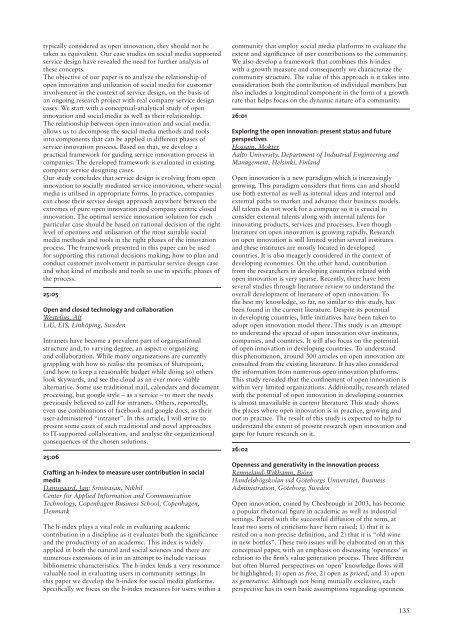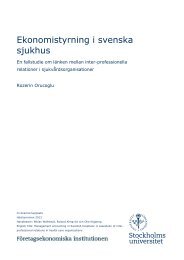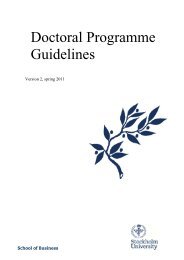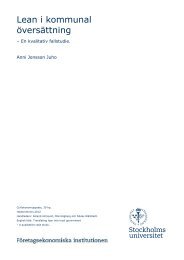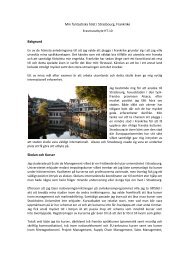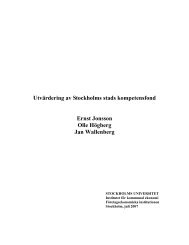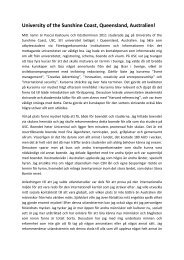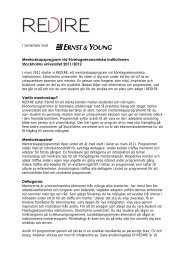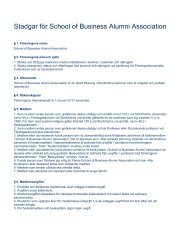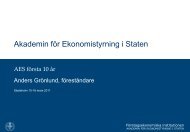Download full programme and abstract book pdf 1.6
Download full programme and abstract book pdf 1.6
Download full programme and abstract book pdf 1.6
Create successful ePaper yourself
Turn your PDF publications into a flip-book with our unique Google optimized e-Paper software.
typically considered as open innovation, they should not be<br />
taken as equivalent. Our case studies on social media supported<br />
service design have revealed the need for further analysis of<br />
these concepts.<br />
The objective of our paper is to analyze the relationship of<br />
open innovation <strong>and</strong> utilization of social media for customer<br />
involvement in the context of service design, on the basis of<br />
an ongoing research project with real company service design<br />
cases. We start with a conceptual-analytical study of open<br />
innovation <strong>and</strong> social media as well as their relationship.<br />
The relationship between open innovation <strong>and</strong> social media<br />
allows us to decompose the social media methods <strong>and</strong> tools<br />
into components that can be applied in different phases of<br />
service innovation process. Based on that, we develop a<br />
practical framework for guiding service innovation process in<br />
companies. The developed framework is evaluated in existing<br />
company service designing cases.<br />
Our study concludes that service design is evolving from open<br />
innovation to socially mediated service innovation, where social<br />
media is utilised in appropriate forms. In practice, companies<br />
can chose their service design approach anywhere between the<br />
extremes of pure open innovation <strong>and</strong> company centric closed<br />
innovation. The optimal service innovation solution for each<br />
particular case should be based on rational decision of the right<br />
level of openness <strong>and</strong> utilisation of the most suitable social<br />
media methods <strong>and</strong> tools in the right phases of the innovation<br />
process. The framework presented in this paper can be used<br />
for supporting this rational decisions making; how to plan <strong>and</strong><br />
conduct customer involvement in particular service design case<br />
<strong>and</strong> what kind of methods <strong>and</strong> tools to use in specific phases of<br />
the process.<br />
25:05<br />
Open <strong>and</strong> closed technology <strong>and</strong> collaboration<br />
Westelius, Alf<br />
LiU, EIS, Linköping, Sweden<br />
Intranets have become a prevalent part of organjsational<br />
structure <strong>and</strong>, to varying degree, an aspect o organizing<br />
<strong>and</strong> collaboration. While many organizations are currently<br />
grappling with how to realise the promises of Sharepoint,<br />
(<strong>and</strong> how to keep a reasonable budget while doing so) others<br />
look skywards, <strong>and</strong> see the cloud as an ever more viable<br />
alternative. Some use traditional mail, calendars <strong>and</strong> document<br />
processing, but google style – as a service – to meet the needs<br />
previously believed to call for intranets. Others, reportedly,<br />
even use combinations of face<strong>book</strong> <strong>and</strong> google docs, as their<br />
user-administered “intranet”. In this article, I will strive to<br />
present some cases of such traditional <strong>and</strong> novel approaches<br />
to IT-supported collaboration, <strong>and</strong> analyse the organizational<br />
consequences of the chosen solutions.<br />
25:06<br />
Crafting an h-index to measure user contribution in social<br />
media<br />
Damsgaard, Jan; Srinivasan, Nikhil<br />
Center for Applied Information <strong>and</strong> Communication<br />
Technology, Copenhagen Business School, Copenhagen,<br />
Denmark<br />
The h-index plays a vital role in evaluating academic<br />
contribution in a discipline as it evaluates both the significance<br />
<strong>and</strong> the productivity of an academic. This index is widely<br />
applied in both the natural <strong>and</strong> social sciences <strong>and</strong> there are<br />
numerous extensions of it in an attempt to include various<br />
bibliometric characteristics. The h-index lends a very resonance<br />
valuable tool in evaluating users in community settings. In<br />
this paper we develop the h-index for social media platforms.<br />
Specifically we focus on the h-index measures for users within a<br />
community that employ social media platforms to evaluate the<br />
extent <strong>and</strong> significance of user contributions to the community.<br />
We also develop a framework that combines this h-index<br />
with a growth measure <strong>and</strong> consequently we characterize the<br />
community structure. The value of this approach is it takes into<br />
consideration both the contribution of individual members but<br />
also includes a longitudinal component in the form of a growth<br />
rate that helps focus on the dynamic nature of a community.<br />
26:01<br />
Exploring the open innovation: present status <strong>and</strong> future<br />
perspectives<br />
Hossain, Mokter<br />
Aalto University, Department of Industrial Engineering <strong>and</strong><br />
Management, Helsinki, Finl<strong>and</strong><br />
Open innovation is a new paradigm which is increasingly<br />
growing. This paradigm considers that firms can <strong>and</strong> should<br />
use both external as well as internal ideas <strong>and</strong> internal <strong>and</strong><br />
external paths to market <strong>and</strong> advance their business models.<br />
All talents do not work for a company so it is crucial to<br />
consider external talents along with internal talents for<br />
innovating products, services <strong>and</strong> processes. Even though<br />
literature on open innovation is growing rapidly, Research<br />
on open innovation is still limited within several institutes<br />
<strong>and</strong> these institutes are mostly located in developed<br />
countries. It is also meagerly considered in the context of<br />
developing economies. On the other h<strong>and</strong>, contribution<br />
from the researchers in developing countries related with<br />
open innovation is very sparse. Recently, there have been<br />
several studies through literature review to underst<strong>and</strong> the<br />
overall development of literature of open innovation. To<br />
the best my knowledge, so far, no similar to this study, has<br />
been found in the current literature. Despite its potential<br />
in developing countries, little initiatives have been taken to<br />
adopt open innovation model there. This study is an attempt<br />
to underst<strong>and</strong> the spread of open innovation over institutes,<br />
companies, <strong>and</strong> countries. It will also focus on the potential<br />
of open innovation in developing countries. To underst<strong>and</strong><br />
this phenomenon, around 300 articles on open innovation are<br />
consulted from the existing literature. It has also considered<br />
the information from numerous open innovation platforms.<br />
This study revealed that the confinement of open innovation is<br />
within very limited organizations. Additionally, research related<br />
with the potential of open innovation in developing countries<br />
is almost unavailable in current literature. This study shows<br />
the places where open innovation is in practice, growing <strong>and</strong><br />
not in practice. The result of this study is expected to help to<br />
underst<strong>and</strong> the extent of present research open innovation <strong>and</strong><br />
gape for future research on it.<br />
26:02<br />
Openness <strong>and</strong> generativity in the innovation process<br />
Remnel<strong>and</strong>-Wikhamn, Björn<br />
H<strong>and</strong>elshögskolan vid Göteborgs Universitet, Business<br />
Administration, Göteborg, Sweden<br />
Open innovation, coined by Chesbrough in 2003, has become<br />
a popular rhetorical figure in academic as well as industrial<br />
settings. Paired with the successful diffusion of the term, at<br />
least two sorts of criticisms have been raised; 1) that it is<br />
rested on a non-precise definition, <strong>and</strong> 2) that it is “old wine<br />
in new bottles”. These two issues will be elaborated on in this<br />
conceptual paper, with an emphasis on discussing ‘openness’ in<br />
relation to the firm’s value generation process. Three different<br />
but often blurred perspectives on ‘open’ knowledge flows will<br />
be highlighted; 1) open as free, 2) open as priced, <strong>and</strong> 3) open<br />
as generative. Although not being mutually exclusive, each<br />
perspective has its own basic assumptions regarding openness<br />
135


